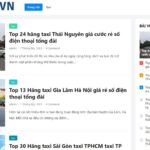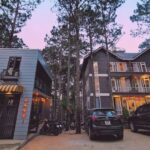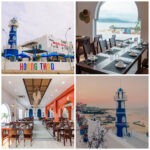Underwear – Sản Phẩm Pierre Cardin
An Phuoc was established in 1992 in southern Vietnam as a sewing workshop to produce export apparel.
Đang xem: Underwear
It was founded by Mrs. Nguyen Thi Dien, a housewife eager to seize any business opportunity that would allow her to escape her life of domesticity. She wanted things to go smoothly and hoped her new business would prosper, so she named it accordingly: “An” means peace and “Phuoc” means prosperity in Vietnamese.
The business took off smoothly and enjoyed strong successes until 1997, when the Asian financial crisis caused sudden market shrinkage for An Phuoc. Its customers either went bankrupt or downsized their businesses. Facing the prospect of having to close down An Phuoc’s factories and make massive employee layoffs, Dien redesigned An Phuoc’s strategy with the aim of exploiting the domestic market in order to sustain production. This strategic change actually brought An Phuoc to new heights and made it one of Vietnam’s most exemplary entrepreneurial firms.
Over the years, An Phuoc’s domestic sales have displayed strong growth (30% on average). While it had only one store in Ho Chi Minh City in December 1997, it now has 60 stores throughout Vietnam and employs 3,200 workers.
At the same time, its foreign sales have also grown dramatically since the end of the Asian financial crisis, and especially since Vietnam developed better trade relations with the United States (U.S.) and the European Union (EU) in the early 2000s. Sales to the EU, the U.S., Japan and Taiwan respectively account for 30%, 20%, 10% and 15% of its export revenue. Recently, An Phuoc’s international sales revenue has been growing at a rate of approximately 20%, and 35-40% of An Phuoc’s revenue now comes from exports.
In addition to its growth in size, market presence and turnover, An Phuoc has received government and consumer recognition many times over. For example, in 1999, it was awarded two gold medals by the Vietnamese General Directorate of Standards and Quality for its long- sleeve shirts and men’s trousers. In 2000, it was awarded three Gold Cups by the same body for its men’s trousers, men’s khaki pants, and men’s short-sleeve shirts. In 2001, An Phuoc was voted a reliable provider of “Vietnamese high quality goods” by consumers throughout Vietnam. In 2004, it was ranked among the top 10 brand names in Vietnam by the Vietnam Economics Times and the Vietnamese Apparel and Textile Association. Most recently, it received the Asia Pacific Super Excellent Brand award.
The 1997 Asian financial crisis caused An Phuoc’s customers (all of whom were from Japan) to shrink their business or even go bankrupt. As a result, they cancelled almost all orders that they had made with An Phuoc, and getting new orders from them in a reasonable time frame was highly unlikely. At the same time, the crisis led to a substantial currency devaluation in neighbouring countries, which caused a relative increase in the prices of goods made in Vietnam and hampered Vietnam’s traditional comparative advantage (i.e., the cost factor). Moreover, access to international markets was limited for Vietnamese firms because of Vietnam’s low integration in the world economy as a result of its macro-economic policies and of the U.S. trade embargo.
This meant it was not feasible for An Phuoc to find another new export market at the time.
In order to sustain production, Dien decided to enter the domestic market, which was dominated by big players such as the Vietnam Textile Corporation, Viet Tien, May 10, etc., despite the fact that An Phuoc did not have its own brand name or any experience.
She noticed that Vietnamese people were getting richer as a result of Vietnam’s dramatic economic growth following the implementation by the government of doi moi (going from a centrally planned economic system to a market-oriented socialist economic system) in 1986. In the meantime, there was little change in the domestic apparel market: apparel (either mass-produced or tailored) was of low quality and there were almost no sales services at all.
Therefore, she decided to create a high-end market niche
She also knew that, when it comes to fashion, Vietnamese consumers prefer imported goods with a foreign cachet. She was convinced that doing business with Pierre Cardin would help An Phuoc compete with the major players in the national clothing manufacturing industry.
She decided to take a big risk: She bought licenses from Pierre Cardin to attract new customers with the brand.
The idea was to attract them to her stores so they would buy An Phuoc products that were of the same quality as Pierre Cardin products, but adapted to Vietnamese body shapes.
She is the first to admit that, at the time, she didn’t realize that she was causing a strategic shift in her company that would change the attitude of Vietnamese consumers to products manufactured domestically.
Xem thêm: Thuế Trước Bạ Xe Máy 2014 /Qđ, Đăng Ký Xe Máy Điện Phải Nộp Phí Trước Bạ
Thanks to her negotiating skills and diplomacy, she was able to acquire a three-year license for the Indochina region (Vietnam, Laos and Cambodia) that was not only exclusive and renewable, but that also offered advantageous terms. The licensor, Pierre Cardin, agreed to provide new creations every season as long as she continued to comply with international quality standards.
Nevertheless, Pierre Cardin’s requirements for fabric quality and the production process significantly increased costs. Dien had to increase her capital five-fold and mobilized it from private sources. Therefore, An Phuoc’s products had to be sold at prices three to five times higher than those of her competitors.
This decision was so audacious that she received frequent negative feedback on how ridiculous her prices were. Indeed, even though Vietnam’s per capita GDP during the late 1990s was under US$400/year, she was trying to sell Pierre Cardin shirts at US$45 each and An Phuoc shirts at about US$20 each.
To entice people to buy An Phuoc’s products, Dien carefully crafted the strategy described below.
Because An Phuoc products were sold at premium prices, the company did not try to sell them to the general public. Rather, it targeted white-collar workers and high-income customers whose appearance is important for their job and/or personal satisfaction. Dien observed that men would always need to wear shirts to the office no matter what. Next, they would wear ties and suits on more formal occasions and in colder weather. Particularly important was the fact that men would not be too picky in terms of pursuing fashion trends.
Therefore, she decided to focus on men’s apparel and accessories for the domestic market during the early phases of developing the An Phuoc brand name. When An Phuoc became a well-known name in Vietnam in 2004, Dien started to diversify its product lines and to market women’s clothing.
What remains consistent for all An Phuoc’s product lines is that they are unique, creative designs and have distinctive colours and well-crafted forms that fit Vietnamese builds.
Throughout this development phase, An Phuoc never abandoned foreign markets. Vietnamese consumers believe that apparel exporters produce higher-quality goods than domestic producers because foreign customers are more demanding. Therefore, Dien exploited this psychological effect in her advertising campaigns by systematically drawing attention to An Phuoc’s exports.
Due to the dual nature of her clienteles, Dien established two types of customer service: one for end-users in the domestic market and the other for international outsourcers. For the former group, her aim was to foster a feeling of pride in buying made-in-Vietnam goods and to increase their willingness to pay premium prices. For the latter group, her objective was to convince customers that An Phuoc was a reliable supplier that could meet any production requirements.
An Phuoc company organized continual training workshops for all store managers as well as store attendants and agents. For each training session, they spent several weeks at An Phuoc’s headquarters at the company’s expense (food, lodging and transportation). Trainers were well- known Vietnamese academics and practitioners. The training programs were carefully designed to ensure that An Phuoc’s sales force complied with company policy, served their customers with diligence and provided the most enjoyable shopping experience to anyone who set foot in an An Phuoc store, be it to buy or window shop.
In Dien’s view, when someone entered her store, it was already an initial success. Customers may be deterred by prices, but would certainly come back at some point in the future to buy if they were warmly received by solicitous store assistants who showed how much they cared and understood customer tastes. She strongly believed that store assistants’ attitude was the key catalyst to luring visitors into a buying mode. Therefore, she made frequent visits to her stores as a “ghost shopper” to check up on her salespeople. When she found problems, she held workshops to retrain sales staff. To convert buyers into loyal customers, Dien allowed them to exchange products within 30 days from the date of purchase to ensure that they were completely happy with their purchase. This was a very rare practice in Vietnam. She also solicited customer feedback to improve An Phuoc’s service.
For foreign outsourcers, the nature of customer services in B2B settings was different from B2C settings. Dien chose to build strategic alliances rather than working on a transactional basis. She nurtured the relationship with business customers to encourage future purchases by treating them as family. She made every effort to ensure not only that all technical requirements (such as stitches, fabric layout, etc.) were met, but also that goods were shipped on time.
For the domestic market, Dien decided to sell her products in her own stores only. To attract high-end buyers, all An Phuoc’s stores had a distinctive thematic décor that created an atmosphere of luxury and elegance.
An Phuoc’s stores were strategically positioned in expensive shopping malls and on the main roads to make them convenient for shoppers. Moreover, the names An Phuoc and Pierre Cardin were always together and relatively large so they could easily be seen from a distance. Since red is the colour of luck and prosperity in Vietnam, it was chosen as the colour theme for An Phuoc’s displays.
Xem thêm: Ngôi Nhà Biệt Thự Trệt Mái Thái Đẹp Hiện Đại Tại Củ Chi, 10 Mẫu Thiết Kế Biệt Thự Trệt
An Phuoc Company is honored to be a strategic partner with Societe de Gestion Pierre Cardin, France in exclusive distribution of high-end men”s fashion products such as Men dress shirt, T-shirts, suits, jackets, leather accessories, bags, suitcases, men”s and women”s socks in Vietnam-Laos-Cambodia market for over 25 years.
Mrs.Nguyen Thi Dien – General Manager ofAn Phuoc Garment, Embroidery and Shoes Company Ltd






Bình luận